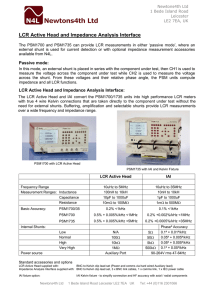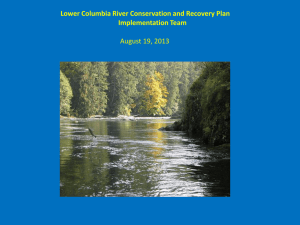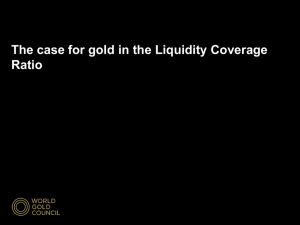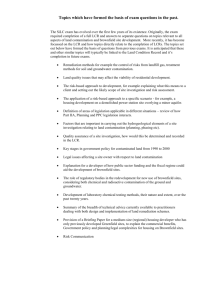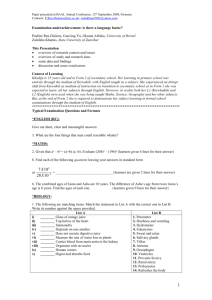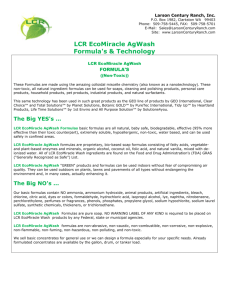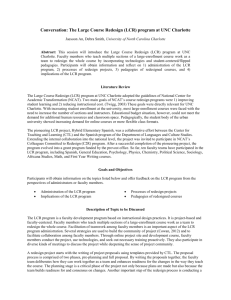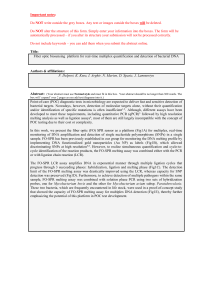High Quality Liquid Assets
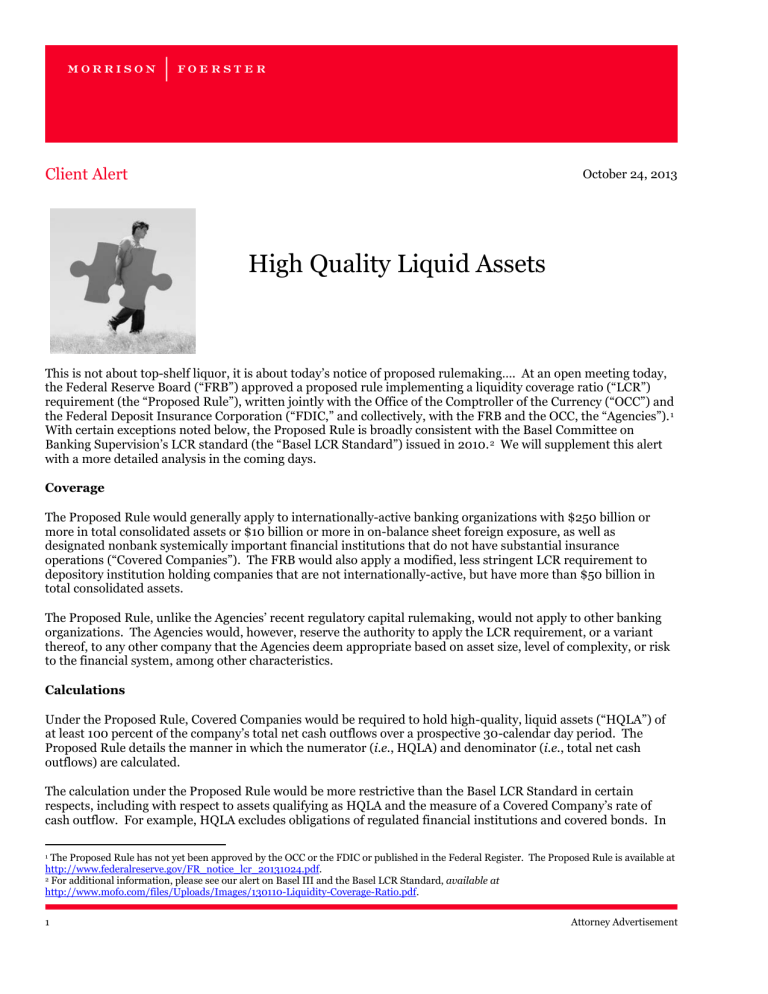
Client Alert
October 24, 2013
High Quality Liquid Assets
This is not about top-shelf liquor, it is about today’s notice of proposed rulemaking…. At an open meeting today, the Federal Reserve Board (“FRB”) approved a proposed rule implementing a liquidity coverage ratio (“LCR”) requirement (the “Proposed Rule”), written jointly with the Office of the Comptroller of the Currency (“OCC”) and the Federal Deposit Insurance Corporation (“FDIC,” and collectively, with the FRB and the OCC, the “Agencies”).
With certain exceptions noted below, the Proposed Rule is broadly consistent with the Basel Committee on
Banking Supervision’s LCR standard (the “Basel LCR Standard”) issued in 2010.
2 We will supplement this alert
with a more detailed analysis in the coming days.
Coverage
The Proposed Rule would generally apply to internationally-active banking organizations with $250 billion or more in total consolidated assets or $10 billion or more in on-balance sheet foreign exposure, as well as designated nonbank systemically important financial institutions that do not have substantial insurance operations (“Covered Companies”). The FRB would also apply a modified, less stringent LCR requirement to depository institution holding companies that are not internationally-active, but have more than $50 billion in total consolidated assets.
The Proposed Rule, unlike the Agencies’ recent regulatory capital rulemaking, would not apply to other banking organizations. The Agencies would, however, reserve the authority to apply the LCR requirement, or a variant thereof, to any other company that the Agencies deem appropriate based on asset size, level of complexity, or risk to the financial system, among other characteristics.
Calculations
Under the Proposed Rule, Covered Companies would be required to hold high-quality, liquid assets (“HQLA”) of at least 100 percent of the company’s total net cash outflows over a prospective 30-calendar day period. The
Proposed Rule details the manner in which the numerator (i.e., HQLA) and denominator (i.e., total net cash outflows) are calculated.
The calculation under the Proposed Rule would be more restrictive than the Basel LCR Standard in certain respects, including with respect to assets qualifying as HQLA and the measure of a Covered Company’s rate of cash outflow. For example, HQLA excludes obligations of regulated financial institutions and covered bonds. In
2
1 The Proposed Rule has not yet been approved by the OCC or the FDIC or published in the Federal Register. The Proposed Rule is available at http://www.federalreserve.gov/FR_notice_lcr_20131024.pdf
.
For additional information, please see our alert on Basel III and the Basel LCR Standard, available at http://www.mofo.com/files/Uploads/Images/130110-Liquidity-Coverage-Ratio.pdf
.
1 Attorney Advertisement
addition, under the Proposed Rule, the measure of a Covered Company’s rate of cash outflow is based on the company’s largest net cumulative cash outflow day within a 30-day liquidity stress, while under the Basel LCR
Standard it is based on the net cumulative cash outflow as of the end of the period.
Flexibility
Like the Basel LCR Standard, the Proposed Rule would provide flexibility for a Covered Company to meet unforeseen liquidity needs arising from idiosyncratic and systemic stress events. A Covered Company could, with notice to its primary federal regulator, sustain a short-term LCR shortfall. However, if a Covered Company’s shortfall remains for three consecutive business days, it would be required to submit a remediation plan to its primary federal regulator.
Implementation
The Proposed Rule would provide for a shorter transition period than is contemplated in the Basel LCR Standard.
According to the supplementary information published with the Proposed Rule, “[t]he agencies are proposing an accelerated transition period for covered companies to build on the strong liquidity positions these companies have achieved since the recent financial crisis.” Under the Proposed Rule, Covered Companies would be required to maintain an LCR of 80 percent as of January 1, 2015; an LCR of 90 percent as of January 1, 2016; and an LCR of 100 percent as of January 1, 2017.
Comment Period
The Agencies have allowed an extended comment period on the Proposed Rule; comments on the proposal are due by January 31, 2014.
Conclusion
The proposal of the LCR would establish the first regulatory requirement for banking organizations to maintain specified levels of liquidity. An additional proposal to implement the net stable funding ratio, which is also provided for in Basel III, can be expected in the foreseeable future. We expect that the details of the Proposed
Rule will have far-reaching effects on banking institutions, their customers, and markets more broadly.
Contacts
Oliver I. Ireland
Washington, D.C.
(202) 788-1614 oireland@mofo.com
Anna T. Pinedo
New York
(212) 468-8179 apinedo@mofo.com
Jeremy R. Mandell
Washington, D.C.
(202) 887-1505 jmandel@mofo.com
2 Attorney Advertisement
About Morrison & Foerster
We are Morrison & Foerster—a global firm of exceptional credentials. Our clients include some of the largest financial institutions, investment banks, Fortune 100, technology and life sciences companies. We’ve been included on The American
Lawyer’s A-List for 10 straight years, and Fortune named us one of the “100 Best Companies to Work For.” Our lawyers are committed to achieving innovative and business-minded results for our clients, while preserving the differences that make us stronger. This is MoFo. Visit us at www.mofo.com
. © 2013 Morrison & Foerster LLP. All rights reserved.
For more updates, follow Thinkingcapmarkets, our Twitter feed: www.twitter.com/Thinkingcapmkts .
Because of the generality of this update, the information provided herein may not be applicable in all situations and should not be acted upon without specific legal advice based on particular situations.
3 Attorney Advertisement

